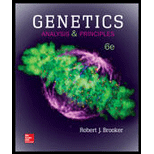
Concept explainers
As mentioned in Experimental Question E11, red eyes is the wild-type
146 purple eyes
151 sepia eyes
50 purplish sepia eyes
444 red eyes
Explain this pattern of inheritance. Conduct a chi square analysis to see if the experimental data fit your hypothesis.
To analyze:
The inheritance pattern when the number of F1 offspring with purple, sepia, purplish sepia and red eyes was 146, 151, 50, 444 respectively. Conducting a chi-square analysis to test whether. the data fits in the proposed hypothesis.
Introduction:
Chi-square (often written
Explanation of Solution
Red-eye is the wild type phenotype. Purple color and sepia eye color also exist, but are recessive to the red eye color. Flies with purple eyes were crossed with sepia eyed individuals. This cross yielded
This approximately equals to
Cross 1: Individual with purple eye color prprsep+sep+XIndividual with sepia eye color pr+pr+sepsep
| prsep+ | prsep+ | prsep+ | prsep+ | |
| pr+sep | pr+prsep+sep | pr+prsep+sep | pr+prsep+sep | pr+prsep+sep |
| pr+sep | pr+prsep+sep | pr+prsep+sep | pr+prsep+sep | pr+prsep+sep |
| pr+sep | pr+prsep+sep | pr+prsep+sep | pr+prsep+sep | pr+prsep+sep |
| pr+sep | pr+prsep+sep | pr+prsep+sep | pr+prsep+sep | pr+prsep+sep |
All the individuals in the F1 generation will be pr+prsep+sep.Both genes are present in dominant heterozygous condition thus, the color of the eye will be red.
The F1 offspring are mated with each other in the following cross:
Cross 2: pr+prsep+ sep (red eye) Xpr+ prsep+ sep (red eye)
| pr+sep+ | pr+sep | prsep+ | prsep | |
| pr+sep+ | pr+pr+sep+sep+ red eye |
pr+pr+sep+sep red eye |
pr+prsep+sep+ red eye |
pr+prsep+sep red eye |
| pr+sep | pr+pr+sepsep+ red eye |
pr+pr+sepsep sepia eye |
prpr+sepsep+ red eye |
prpr+sepsep sepia eye |
| prsep+ | pr+prsep+sep+ red eye |
pr+prsep+sep red eye |
prprsep+sep+ purple eye |
prprsep+sep purple eye |
| prsep | pr+prsep+sep red eye |
pr+prsepsep sepia eye |
prprsepsep+ purple eye |
prprsepsep purplish sepia |
This type ofpattern of inheritance is known as the complement system. The protein product of both pr+ and sep+genesis needed for red coloring, but if one of them is absent, the phenotype changes. The individual having homozygous alleles for purple will have purple eyes and the individual having the homozygous allele for sepia will have sepia eyes. The individual having both the genes in homozygous recessive condition will have purplish sepia eyes.
There isa total of four phenotypes in the F2 generation. A total number of individual in F2 generation is
Proposed Hypothesis: The pattern of inheritance is complementation type and both genes are required to produce red eye coloration in flies.The cross between pr+prsep+sep (red eye) and pr+prsep+sep(red eye) will yield 9:3:3:1 ratio in the F2 generation.
Based on this hypothesis, calculating the expected values of two phenotypes:
| Observed phenotype (O) | Expected phenotypes(E) |
| 444 red eyes | |
| 146 purple eyes | |
| 151 sepia eyes | |
| 50 purplish sepia eyes |
The population data falls into four sets in this question so, the chi-square calculation wouldbe done by the formula:
The values of Observed phenotypes (O) and Expected phenotypes (E) are
Applying the formula for chi-square,
The formula for measuring the degrees of freedom is
Therefore, it can be concluded that the eye color in Drosophila is governed by two genes sep+ and pr+, when both of them are present, the eye color is red. When two red-eyed individuals withpr+prsep+ sep (red eye) and pr+ prsep+ sep (red eye) genotype are crossed together,
Want to see more full solutions like this?
Chapter 4 Solutions
Genetics: Analysis and Principles
- Not part of a graded assignment, from a past midtermarrow_forwardNoggin mutation: The mouse, one of the phenotypic consequences of Noggin mutationis mispatterning of the spinal cord, in the posterior region of the mouse embryo, suchthat in the hindlimb region the more ventral fates are lost, and the dorsal Pax3 domain isexpanded. (this experiment is not in the lectures).a. Hypothesis for why: What would be your hypothesis for why the ventral fatesare lost and dorsal fates expanded? Include in your answer the words notochord,BMP, SHH and either (or both of) surface ectoderm or lateral plate mesodermarrow_forwardNot part of a graded assignment, from a past midtermarrow_forward
- Explain in a flowcharts organazing the words down below: genetics Chromosomes Inheritance DNA & Genes Mutations Proteinsarrow_forwardplease helparrow_forwardWhat does the heavy dark line along collecting duct tell us about water reabsorption in this individual at this time? What does the heavy dark line along collecting duct tell us about ADH secretion in this individual at this time?arrow_forward
 Concepts of BiologyBiologyISBN:9781938168116Author:Samantha Fowler, Rebecca Roush, James WisePublisher:OpenStax College
Concepts of BiologyBiologyISBN:9781938168116Author:Samantha Fowler, Rebecca Roush, James WisePublisher:OpenStax College Human Heredity: Principles and Issues (MindTap Co...BiologyISBN:9781305251052Author:Michael CummingsPublisher:Cengage Learning
Human Heredity: Principles and Issues (MindTap Co...BiologyISBN:9781305251052Author:Michael CummingsPublisher:Cengage Learning Biology (MindTap Course List)BiologyISBN:9781337392938Author:Eldra Solomon, Charles Martin, Diana W. Martin, Linda R. BergPublisher:Cengage Learning
Biology (MindTap Course List)BiologyISBN:9781337392938Author:Eldra Solomon, Charles Martin, Diana W. Martin, Linda R. BergPublisher:Cengage Learning Human Biology (MindTap Course List)BiologyISBN:9781305112100Author:Cecie Starr, Beverly McMillanPublisher:Cengage Learning
Human Biology (MindTap Course List)BiologyISBN:9781305112100Author:Cecie Starr, Beverly McMillanPublisher:Cengage Learning Biology: The Dynamic Science (MindTap Course List)BiologyISBN:9781305389892Author:Peter J. Russell, Paul E. Hertz, Beverly McMillanPublisher:Cengage Learning
Biology: The Dynamic Science (MindTap Course List)BiologyISBN:9781305389892Author:Peter J. Russell, Paul E. Hertz, Beverly McMillanPublisher:Cengage Learning Biology 2eBiologyISBN:9781947172517Author:Matthew Douglas, Jung Choi, Mary Ann ClarkPublisher:OpenStax
Biology 2eBiologyISBN:9781947172517Author:Matthew Douglas, Jung Choi, Mary Ann ClarkPublisher:OpenStax





